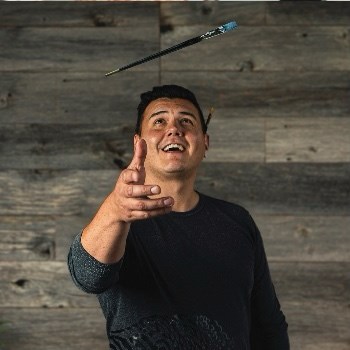The 2022 Winter Olympics may be over but Patrick Hunter’s Indigenous-styled artwork that adorned the jerseys of Canada’s Olympic curling teams, still remains as a visible sign of his talent as an artist.
Patrick Hunter, originally from Red Lake, Ontario, is a two-spirit Ojibway artist, graphic designer and entrepreneur who contributed Indigenous-styled artwork to Canada’s curling attire for the Beijing 2022 Winter Olympics. In 2011, he moved to Toronto to pursue a career in the arts after completing a graphic design program at Sault College in Sault Ste. Marie.
Recognizing that his cultural background was an asset to his success, he launched Patrick Hunter Art and Design in 2014. He specializes in fine and digital artwork and designs from his Ojibway roots with the intent to “create a broader awareness of Indigenous culture and iconography”.
When reflecting on the use of his artistry on the Canadian Olympic curling team jersey, Patrick Hunter says, it’s "bizarre" to see his Indigenous artwork on display at the 2022 Winter Olympics.
Hunter collaborated with Winnipeg-based curling apparel company Dynasty Curling to design the uniforms for Canada’s Olympic curling teams.
When asked in previous interviews about the focus of his design, Hunter says, “I just did a lot of the Indigenous-style artwork for it. On the back is a maple leaf - within the maple leaf, I did a lot of the more organic lines that are inside of it. There’s seven trees on the torso that are derived from the seven grandfather teachings. I’m Ojibway, so that’s where those come from."
Hunter also added symbols from his Indigenous roots on the sleeves of the jerseys. “I wanted to send them off with a lot of positive vibes, so on the arm are the four medicines of my people - sage, cedar, tobacco and sweetgrass,” he said.
As an Indigenous artist, Hunter looks forward to, “creating a positive future for his people”, which has made him the first Artist in Residence for the Prince’s Trust Canada, a Royal charity in which helps with the reclamation of Indigenous languages in Canada.
Moving to a big city like Toronto and trying to find employment was something that could no doubt have added more challenges, but embracing his Ojibway heritage has helped change all of that.
He describes this journey best when he shares that, “When I really leaned into who I was as a person and my culture, that’s when success really kind of came about”.
As for the future Hunter says he’d like to do more artwork for the Olympics in the future, but lately, he’s been looking at real estate in Sault Ste. Marie, where he hopes to create a base where he can position himself as a supplier of Indigenous, made-in-Canada products. He sees Sault Ste. Marie as, “a good place to land after all of this stuff."



